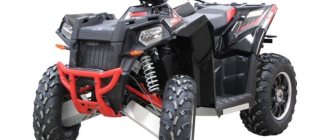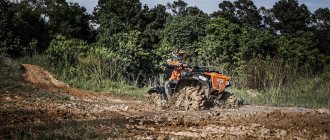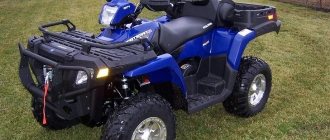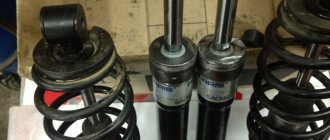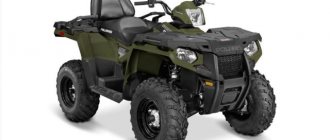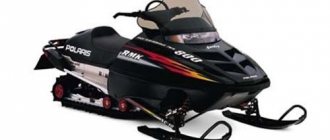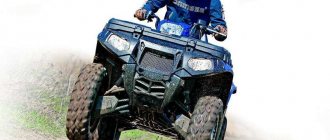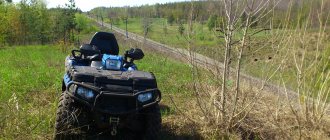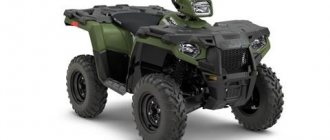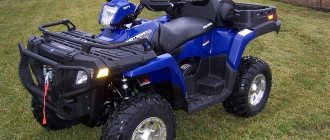The manufacturer Polaris specializes in the serial production of various motorcycles, which includes both snowmobiles and ATVs. Now the range of ATVs includes a very large number of types intended for specific applications. For touring riding, the manufacturer provided the Polaris SPORTSMAN TOURING 500 model. One of the main differences between this ATV and most others is the location of the passenger seat; here it is installed immediately behind the driver’s seat. The passenger seat has a comfortable backrest. The model also includes adjustable footrests. All this together provides not only excellent ride comfort, but also a fairly high level of safety. In addition, it is necessary to highlight the design of the seat itself, which provides excellent visibility of the area for both the driver and the passenger.
But this is not all that distinguishes this ATV from many analogues. In order to ensure improved performance, the manufacturer has endowed the equipment with the following technological features:
- All-wheel drive with automatic engagement.
- 500 cc power plant, complemented by a carburetor fuel system and liquid cooling. The motor also has quite good torque.
- Rear suspension with A-shaped arms, thanks to which a high smoothness and, accordingly, comfort is achieved.
- The motor provides both electric and manual starting.
- There is an electric power steering mechanism.
When developing the Polaris Touring 500 model, many little things were also taken into account. For example, the engine radiator was mounted much higher than the chassis of the ATV and tilted slightly back. This solution made it possible to prevent the radiator from clogging with dirt when driving off-road.
The stability of the ATV has been positively affected by the new EBS braking system. This system includes hydraulic disc brakes on all four wheels. The brakes are controlled by a special brake lever, but if you need to brake only the rear wheels, then a pedal is also provided here. In addition, the high stability of the equipment is also due to the extended wheelbase in combination with the displacement of the power plant to the rear. The offset itself was made not only to improve stability, but also to install the seat, since the two-seater seat required just such an arrangement.
Winch included
Of course, if you are not going to ride only near your home and nearby villages, but want to get closer to nature, the winch comes included!!! Moreover, the official dealer Brandt Kemerovo on Leningradsky Ave. 28/1 offers a wide range of accessories and additional equipment at attractive prices.
The two-seater Polaris Sportsman 500 Touring ATV has a longer wheelbase than the single one. It's a pleasure to ride.
First quad bike. Story
The history of the Polaris ATV dates back to 1954. More than half a century ago, Orlen Johnson, together with David Johnson and Paul Nochenmus, created the first Polaris snowmobile, which began the rapid development of the company in the motorcycle industry. The first ATVs and snowmobiles, of course, were primitive and looked completely different from how we are used to seeing snowmobiles and ATVs now, but, nevertheless, even then they could work in difficult climatic conditions and many wanted to buy an ATV or snowmobile to help themselves .
The prototypes of modern 4-wheeled ATVs were the 3-wheeled ATC - All Terrain Cycles - “all-terrain motorcycles” produced since 1969 by the Japanese company Honda. The all-terrain capability of this model was very conditional, but this layout made it possible to drive off the asphalt, drive along dirt paths and sand dunes, and also “mix” not deep mud and even snow. However, the 3-wheel formula began to be gradually replaced by models with 4 wheels, and here again the Japanese motorcycle manufacturers acted as legislators: Honda, Yamaha, Suzuki, Kawasaki.
But the real breakthrough was the release by Polaris Industries in 1985 of the first 4-wheel ATV in the United States, Polaris Trail Boss, which for the first time used innovative technical solutions that were revolutionary for that time, such as a CVT automatic transmission (PVT) and a MacPherson-type ATV front suspension. , long-travel rear suspension, four-wheel disc brakes and full-length solid running boards.
This ATV model, having become the standard of a full-fledged 4-wheel ATV for many years, greatly revived the ATV market. Almost every person who is interested in ATVs wanted to buy an ATV from Polaris. And at the same time, each of the motorcycle manufacturers tried to release some new ATVs, trying to attract buyers with engine size, equipment, and additional capabilities. However, none of the above-mentioned brands (Honda, Yamaha, Suzuki, Kawasaki), nor those that joined the fight for the ATV market much later, in the second half of the 90s, Arctic Cat and BRP (Bombardier Recreational Product) with the Can-Am brand, were able to displace ATVs Polaris (Polaris) from the pedestal of the leader in the world of motorcycles.
And everything is fine with the iron!
As for the technical part, here it is in no way inferior to its competitors. Connectable all-wheel drive, low gear, as well as a hill descent control system. It easily tows a car trailer up to 550 kg; there are quite convenient platforms in front and behind where you can also put everything you need on the road.
And the fuel tank capacity is 15 liters, I note that the baby has a fairly moderate appetite. It’s probably difficult to convey all the sensations that a Sportsman gives you when driving. You just have to try it.
Specifications
Power point:
- Number of cylinders - 1.
- Working volume - 500 cubic meters.
- Rated output power is 39 horsepower/29 kilowatts (at 5500 rpm).
- The highest torque is 56 newtons per meter (at 4250 rpm).
- Number of camshafts - 1.
- The camshaft location is overhead (SOHC).
- Number of valves - 2.
- Cooling system type: liquid.
- Type of lubrication system - oil bath.
- Fuel system type: carburetor.
- Recommended fuel is AI-92.
- Type of ignition system: contactless electronically controlled (CDI).
- Starting system type: electric starter.
Chassis:
- Drive type - full.
- Transmission system type: CVT.
- Frame type: tubular steel.
- Clutch type - centrifugal automatic.
- Front suspension type: independent McPherson with horizontal and vertical travel.
- Rear suspension type: independent with A-arms with horizontal and vertical travel.
- The front suspension travel is 208 millimeters.
- Rear suspension travel is 222 millimeters.
- Front tires - 25x8-12.
- Rear tires - 25x11-12.
- Front disc type: stamped steel.
- The type of rear discs is stamped steel.
- Front brake type: hydraulic disc.
- Rear brake type: hydraulic disc.
- Power steering type: electric.
Dimensions:
- Structural length - 2184 millimeters.
- The structural width is 1219 millimeters.
- The structural height is 1219 millimeters.
- Seat height is 857 millimeters.
- Wheelbase length -1448 millimeters.
- The lowest ground clearance is 279 millimeters.
- The smallest turning radius is 3200 millimeters.
Other characteristics:
- The capacity of the fuel tank is 15.5 liters.
- The maximum weight of cargo transported on the front trunk is 51 kilograms.
- The maximum weight of cargo transported on the rear trunk is 71 kilograms.
- The curb weight of the ATV is 335.7 kilograms.
Second full seat
It's comfortable to drive both tall and not so tall. The instrumentation is easy to read both in the sun and at night. But the main highlight of the Touring, which distinguishes it from its single-seat brothers, is the second, full-fledged seat.
There is also the Sportsman 550 X2, Sportsman 850 X2, but the second seat is not large because “X-second” is more designed to transport a passenger from point A to point B, and is positioned on the market as an assistant in the household. Indeed, thanks to the box at the back, it is more versatile.
It is worth noting that the second seat on the Sportsman 550/850 X2 is not at all large. but thanks to the box at the back it is more versatile.
Two-seater “athlete” from Polaris
Its "pedigree" and design
It’s not for nothing that devices of this kind are called “four-wheeled motorcycles.” Enduro bikes are not their distant cousins at all, but their closest “relatives.” Energy-intensive long-travel suspensions, high-torque engines, “toothy” tires with developed lugs allow them to easily move not only on broken and muddy dirt and forest roads, but also where instead of roads there are only directions.
This technique, by the way, is very popular all over the world and attracts more and more fans every year. The secret of this phenomenon lies in its versatility. “Four-wheelers” (or, as they are also called, ATV - All-Terrain Vehicle) are capable of transporting cargo, towing a trailer, and, if necessary, clearing snow in front of the house. Well, with the help of a wide range of additional equipment, many of them can easily turn into almost mini-tractors: all-wheel drive allows you to do a lot.
If you press the accelerator lever well, you can get real pleasure from driving. The motocross track is, perhaps, for a special subspecies of ATV, uncompromising racing models, but you can go through the forest paths and rush around the surrounding fields to your heart's content even on utilitarian models.
The Sportsman X2 500 EFI belongs to such multifunctional four-wheelers. In the Polaris model range of all-terrain vehicles, the Sportsman family is allocated, in fact, to a separate class and occupies a niche between sports and utilitarian models and represents a kind of symbiosis of the best qualities of representatives of both classes.
X2 is the first 2-seater model in the line (hence the name). Moreover, the back of the rear seat can be folded, and in this case the rear trunk will increase slightly. By the way, partly for reasons of passenger safety, the ATV was equipped not with the most powerful 800 cc, but with a 499 cc single-cylinder 4-stroke liquid-cooled engine with a power of 49 hp. With. Not enough? For a device with a dry weight of 362 kg - just right. In case anyone has forgotten, quite recently other small cars were equipped with engines of similar power...
The gearbox is a proprietary automatic V-belt variator PVT (Polaris Variable Transmission), interlocked with the transfer case. The latter has a reduction gear with a gear ratio of 23.91:1. The gearbox is equipped with reverse. Torque is transmitted to the wheels by cardan shafts; Moreover, the driver is at any time free to choose between all-wheel drive, 2x4 and automatic mode, when the 4x4 drive is activated independently if necessary.
The device’s suspension can easily be called “automotive”: McPherson struts at the front and a completely independent design at the rear. “Something sounds familiar,” doesn’t it? Not every car, however, has suspension strokes reaching 22 cm. Just as not every SUV is now equipped with a transmission with a reduction gear and manually activated all-wheel drive.
Well, we had to find out during the test how this whole construct works in practice and how successful the compromise between sporting and utilitarian qualities was found by the developers.
"Across the valleys and the hills..."
We decided to conduct filming and test runs near the village of Koltushi. We found a quiet, picturesque corner: a couple of small lakes, a winding dirt road winding between them, sandy ravines and slopes, an almost flat field - there was a place to have a good time and test our “Sportsman” in combat mode.
Control of the device is organized simply and intuitively. The engine starts electrically, but just in case there is a backup (with a starter cord). Under the left hand there is a handbrake and a low/high beam switch, under the right hand there is a switch for drive modes and an accelerator lever under the thumb. Transmission modes are activated by a lever located on the right side of the device body. It is 5-position: H/L/N/R/P (respectively, “upshift”, “downshift”, “neutral”, “reverse” and “park”).
The ATV starts moving, at first glance, lazily: more precisely, with a second delay necessary for the engine to spin up a little and “grab” the variator. But after that - no “thinking”. Gas - and the device “tears its soles”! Moreover, once you get the hang of it, the traction force can be dosed very precisely: start smoothly if there is loose sand, dirt, or clay under the wheels; or actively, with slipping, if you want to come off in full.
The Sportsman also reacts to steering inputs without any hesitation. It easily enters turns without struggling, tenaciously holds the trajectory and accelerates powerfully at the exit. True, it rolls mercilessly: the suspensions are long-travel, the center of gravity is located relatively high, and the overall height of the model, do not forget, is equal to its width. But if, when going through a turn, you lean into the bend ahead of time, then all the attempts of the vehicle to capsize are nipped in the bud, and instead it begins to slide outward with its rear wheels, allowing, after a short training, to take turns in a spectacular slide.
While the photographer and I were choosing places and angles for shooting, we also managed to check what it was like for the rear passenger in the Sportsman. As it turned out, it’s quite good: the back seat is comfortable, the backrest is optimally shaped, and there are a couple of convenient handles, very well located. But before setting off on a trip together, it would be a good idea to instruct the passenger so that when cornering, he and the driver lean into the bend.
Well, what about the X2's cross-country ability? There was no place to take a “mud bath,” but we managed to test it in the sand. The Sportsman overcomes medium-steep inclines effortlessly - you don’t even need to engage all-wheel drive, much less lower gear. Feeling emboldened and also realizing the remarkable capabilities of the device, I choose a steeper slope and decide to try to get out of a small ravine. There is dry sand under the wheels. I set the selector on the steering wheel to the “2x4” position, the lever to “L”. Go!
I start from a standstill and don’t really accelerate before the slope to make the task more difficult. Busily grumbling the engine, the Sportsman confidently, without unnecessary tension, drives up, requiring only a slight addition of gas at the very top of the climb. Shine!
The only fly in the ointment was found during frequent switching of transmission and all-wheel drive modes: the gearshift lever and the switch on the steering wheel had low information content. The forces on them are somewhat uncalibrated, and therefore the most common mistake when switching is “overshooting” the desired position. For example, I often turned on “neutral” instead of “reverse” and automatic all-wheel drive instead of “2x4”. Perhaps this is a matter of habit, but during the test I never managed to get used to it.
However, in all other respects, the Polaris Sportsman X2 500 EFI showed its best side: excellent handling and maneuverability, combative, “incendiary” character. It seems that it will suit a wide range of buyers: from summer residents to hunters and fishermen - in general, for lovers of outdoor activities. Behind the wheel of the Sportsman X2 it becomes very, very enjoyable.
